Affiliate disclosure: This post may contain affiliate links. Please see our Privacy Policy.
Yarrow salve offers many medicinal and healing benefits, and it couldn’t be easier to make at home. Yarrow is used topically to treat wounds and skin irritation, and it’s been used since antiquity to help stop bleeding.
Yarrow can be found growing in the wild all throughout the United States and is an important addition to any home remedy collection.
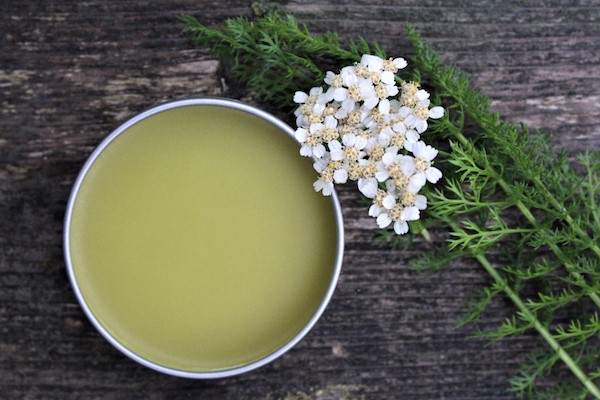
With its soft white flowers and equally soft green leaves, the yarrow plant is a beautiful addition to any garden (which, thanks to its mosquito-repelling properties, is why you’ll often find it planted in backyards and surrounding areas). There are literally dozens of ways to use yarrow for food and medicine, and this yarrow salve is just one of the ways we put it to use.
Yarrow (Achillea millefolium) is also easily found growing in the wild, where it can be foraged and then used to make this salve. If foraging is new to you, read my post about foraging and using yarrow for tips on locating and identifying this plentiful flowering plant.
Be aware that there are other white flowering plants that are toxic, namely poison hemlock, so always be 100% sure of your identification. If you’re not comfortable foraging yarrow, it’s available for purchase at Mountain Rose Herbs, already dried and ready to infuse into the oil for yarrow salve.
If you’re just hoping to find a ready-made salve and skip the DIY portion, I’d suggest checking on Etsy for small-scale cottage industry producers since it’s not something that you’ll find in a store.
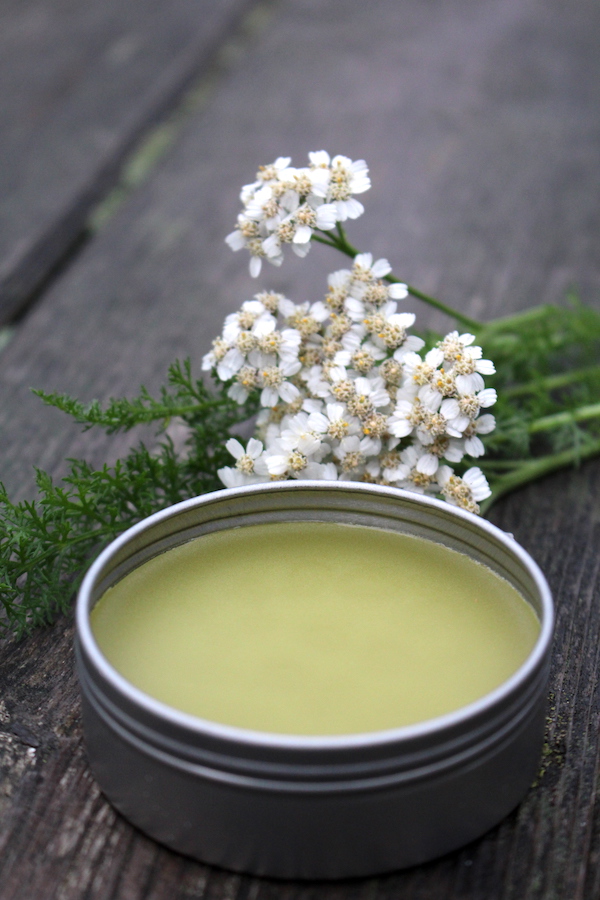
(Always consult your doctor or a clinical herbalist before trying any new herbal remedy, as there’s always the possibility of unintended consequences, allergic reaction, or interactions with other medication. If you’re harvesting wild plant material, make sure you’re 100% confident in your identification and consult multiple sources for your ID. The following is based on my research and experience, but I don’t claim to have any certifications that would qualify me to advise you on your health. Please do your own research and always verify with multiple reputable sources.)
Benefits of Yarrow Salve
Yarrow salve is typically used to treat minor topical injuries, including cuts, scrapes, burns, and rashes. It’s often combined with other skin-soothing and antimicrobial herbs like lavender, lemon balm, and calendula.
The healing and medicinal benefits of yarrow have been known for thousands of years. Over 2,500 years ago Asian yarrow was first used by Chinese doctors to relieve inflammation, bleeding, and animal bites. Yarrow also makes an appearance in Greek mythology; the warrior Achilles is said to have used the herb for its blood-clotting effects on the battlefield!
While the flowers of the yarrow plant are typically used to relieve internal issues such as fever, stomach upset, and menstrual cramping, yarrow leaves are more likely to be used as a topical remedy. Specifically, yarrow leaves have powerful anti-inflammatory, anti-itching, anti-bacterial, wound healing, and blood coagulating properties when applied to the skin.
Scientists have actually been able to replicate these findings in a lab setting. A randomized controlled study published in the Journal of Ethnopharmacology examining the use of yarrow as a topical inflammatory found that, after seven days of continuous reapplication, “The application of tested oil extracts on artificially irritated skin in vivo demonstrated the ability to re-establish their optimal pH and hydration of skin to the values measured prior to the irritation.”
According to Herb Rally, yarrow’s “antiseptic and anodyne properties coupled with its ability to coagulate blood and stop bleeding make it the perfect ally in this case. These properties also make it useful in cases of hemorrhoids, post-partum care, bruises, and mouth sores, as well as internal bleeding.”
Yarrow leaves are one of the best herbs to bring on a camping or hiking trip (or, if you’re comfortable ID-ing yarrow, you can forage it directly from the site). You can make a basic poultice by chewing the leaves and placing them directly onto a burn, mosquito bite, or minor cut for near-instant relief.
Yarrow tends to close wounds quickly, so don’t use it on puncture wounds, and obviously severe wounds should be treated by a doctor or emergency room. This salve is more for minor cuts and scrapes, like skinned knees.
Yarrow should be avoided if you have an allergy to plants in the Asteraceae family (like daisies, ragweed, marigolds, or sunflowers).
To learn more about yarrow’s uses, I’d suggest reading this article on adding yarrow to your herbal materia medica.
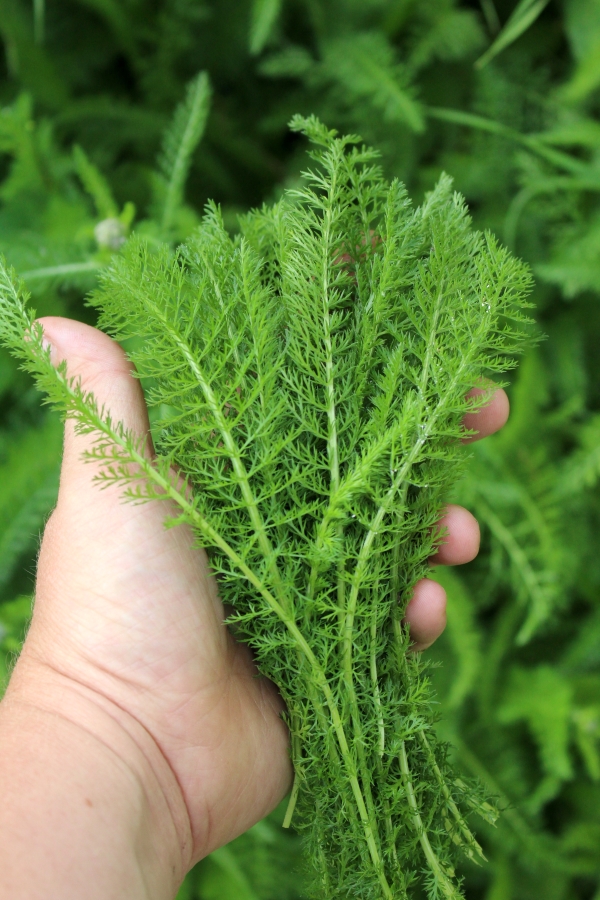
Supplies & Equipment for Making Yarrow Salve
One of the best parts about making homemade herbal salves is the fact that no special equipment is required.
All you need is a simple double broiler, such as this store-bought double boiler, or you can make your own DIY version using a heatproof bowl and a small pot (which is what I usually do).
The herbs are infused into a neutral oil; I like to use olive oil but you can also try grapeseed, coconut or jojoba oil — each of these options have well-known soothing properties when applied to the skin.
Beeswax thickens the salve and helps it set, you can weigh out pieces from a large block of beeswax or pour and measure out beeswax pellets (which I find is a lot easier).
A small kitchen scale is an indispensable, inexpensive kitchen tool for measuring the beeswax (unless you happen to find beeswax in convenient 1 oz bars, like these).
Finally, you’ll need to have containers on hand for the finished salve. I typically like to use 2-ounce salve tins which screw shut and make great gifts. If you prefer the look of glass, you can also use any small jar with a tight-fitting lid, such as quarter pint mason jars.
How to Make Yarrow Salve
Making your own yarrow salve is easier than you might think, the active prep time is only 30 minutes and the rest of the time is hands-off. If you’ve ever made any other healing salves you’ll know the main requirements are patience and consistency (and in fact, because we’re going to use the warm rapid infusion method to make this yarrow salve, the actual patience required for this recipe isn’t all that much).
When it comes to infusing oil with herbs, there are two main methods: rapid infusion and slow infusion.
Fresh herbs, like the yarrow used in this recipe, should always be infused using the warm rapid infusion method. When fresh herbs are stored in oil for several weeks they’ll eventually spoil, releasing water into the oil and causing it to go rancid (which, you’ll know if you’ve ever accidentally smelled or ingested rancid oil, is an unpleasant experience).
The slow infusion method, on the other hand, can be used when dried herbs are added to the oil instead of fresh. This process involves storing the jars in a cool, dry location out of direct sunlight for 3 to 6 weeks. That’s a good option if you’ve purchased dried yarrow.
This salve uses the leaves of the yarrow plant, if you find yourself with an excess of leftover yarrow flowers you can turn them into a soothing hot & moist tea for cold and flu.
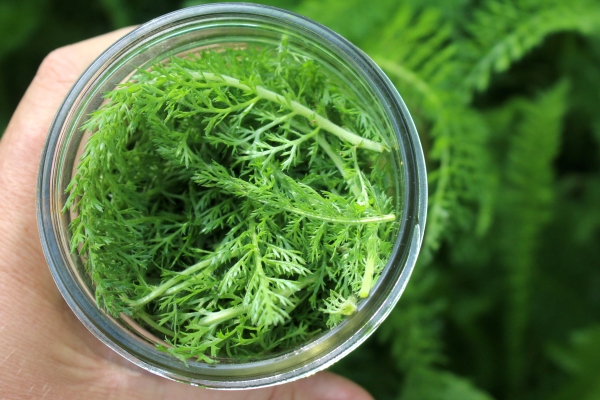
Begin the salve-making process by filling a pint mason jar with yarrow leaves — they should be fairly densely packed.
Since yarrow grows wild all around my land, and the surrounding areas, I actually just bring a mason jar out foraging and pack the leaves right into the jar. It’s a convenient way to measure.
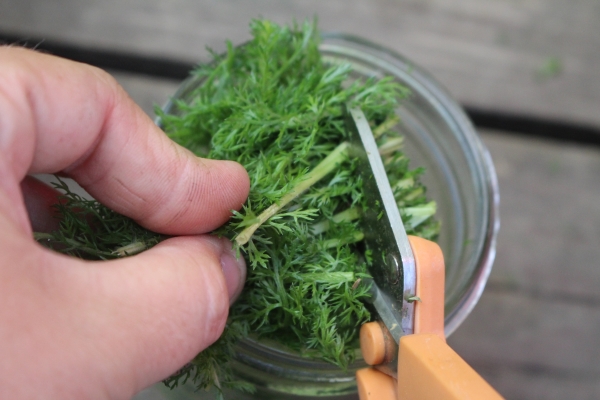
Next, you’ll want to finely chop the yarrow leaves into small pieces using a pair of garden shears or sharp kitchen scissors.
I’ll bring the jar filled with yarrow back to my porch and get to chopping.
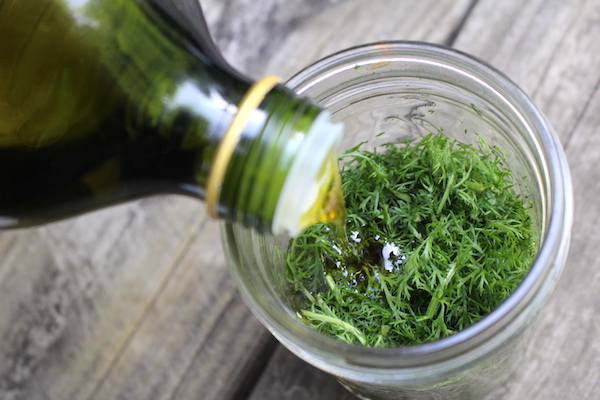
Pour enough olive oil (or other neutral oil of your choice) into the mason jar to cover the chopped leaves.
In this case, I’m just using olive oil from my kitchen, since it’s a nice neutral choice and great for gifts. Almond oil has natural skin-soothing properties, but be sure it’s not used by anyone with nut allergies.
I’ve also used jojoba oil, which mimics your skin’s natural lubricants and is especially nourishing.
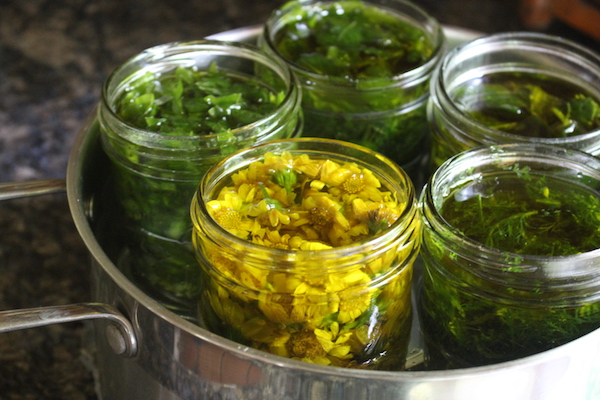
Leaving the jar open, place the jar into a double boiler that’s been filled with about an inch of water on the bottom. If you don’t have a double boiler, you can use also use a saucepan or slow cooker, in which case you’ll need to place the jar on a trivet (I use a canning lid or an old cotton dish towel).
Very slowly, warm the water up to 110 to 120 degrees. Resist the urge to crank the heat during this step, the goal is to gently infuse the oil with yarrow, not to cook the herbs. Overheating the oil will result in the yarrow losing some of its healing properties and medicinal potency.
Allow the yarrow to infuse into the oil for between 24 and 48 hours, keeping the temperature between 110 and 120 degrees. This can be achieved by periodically bringing the water back up to temperature and then turning it off again. Before I go to bed I heat the water up, turn it off, and then place a towel over the pot to keep its contents warm.
Once the oil is infused to your liking, it can be made into the finished salve. Carefully strain out the yarrow leaves from the oil and pour them into a heatproof bowl (we’re going to make another double boiler). Place the bowl over simmering water in a small pot, adding the beeswax and stirring until the mixture is completely incorporated and smooth.
(If you don’t have a kitchen scale to weigh the beeswax, 1 ounce of solid beeswax is roughly equivalent to 1 heaping tablespoon of beeswax pistils).
Pour the liquid yarrow salve into small tins or jars and let it sit for at least 30 minutes.
As a general rule, herbal salves should be used within 1 year of being made.
Apply yarrow salve to bee stings, minor cuts, rashes (including diaper rash), and burns. It’s something I always like to keep on hand, and these small tins are perfect to bring on camping and hiking trips as well as for stashing in a purse or backpack.
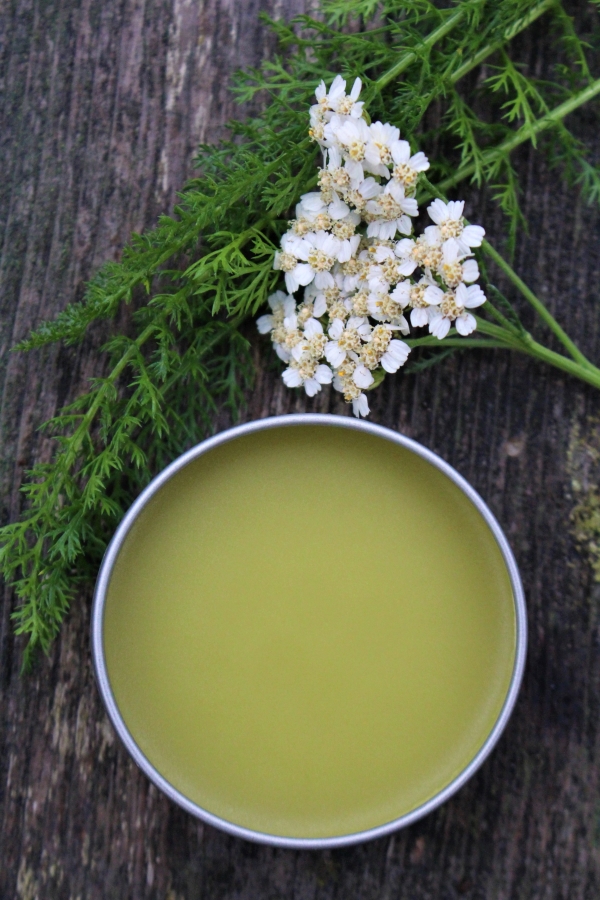
Other Ways to Use Yarrow
Looking for other ways to use yarrow? This article has more than 50 ideas for using yarrow in both food and medicine.
These are some of my other favorite ways to use it when I’m not making salve:
- Homemade Yarrow and Witch Hazel Soap
- Yarrow Tincture
- Yarrow Styptic from Joybilee Farm
- Rose Plaintain & Yarrow Itch Remedy from The Nerdy Farm Wife
- DIY Herbal Cough Drops from The Nerdy Farm Wife
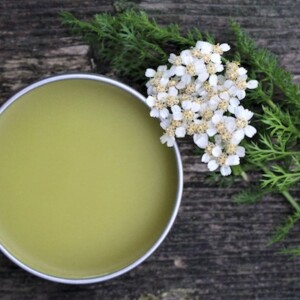
Yarrow Salve
Equipment
Ingredients
- 1 1/2 to 2 cups fresh yarrow leaves
- 1 1/4 to 1 1/2 cups olive oil or any other neutral oil
- 1 ounce bees wax
Instructions
- Gather yarrow from a clean area that hasn’t been sprayed with chemicals. Double-check that you have identified the yarrow properly before beginning this project.
- Roughly chop the yarrow, filling a pint mason jar almost to the top with leaves.
- Pour the olive oil or neutral oil of your choice over the yarrow leaves.
- Fill a saucepan or slow cooker with 1 inch of water. Carefully place the yarrow- and oil-filled jar on a trivet in a double boiler or in the slow cooker.
- Slowly heat the water until it reaches 110 to 120 degrees. Turn off the heat.
- Keep the contents of the jar incubating in the warm water. Bring the water back up to temperature periodically over the next 24 to 48 hours, never leaving the heat on for any prolonged amount of time and never allowing the water line to get too low.
- When the oil is completely infused, strain out the yarrow leaves.
- Pour the infused yarrow oil into a heatproof bowl, place the bowl over a pot of gently simmering water, creating another double boiler.
- Stir in the beeswax and let it slowly melt into the oil. Remove from the heat once the beeswax is completely incorporated.
- Carefully pour the oil and beeswax combination into prepared salve tins or small jars.
- Let the salve cool and set completely before using, around 30 minutes.
Notes
Homemade Herbal Salve Recipes
Looking for more homemade herbal salve tutorials?
Disclaimer on Homemade Herbal Remedies
I’ve been foraging wild medicines and treating my family with herbal remedies for the past 20 years, but I’m self-taught. Be aware that I am not a clinical herbalist, and this is based on my own research and personal experience using medicinal plants. I do not claim to have the experience that’d qualify me to advise you on your health, and I’m only providing this as a reference to encourage a broader interest in medicinal plants.
Please use this as a jumping-off point, but always do your own research and verify anything you read with multiple sources.
It’s always possible to have an adverse reaction to any medicinal herb, and plenty of people are allergic to even gentle herbs like chamomile. Always consult your doctor or a certified herbalist before trying any new medicinal plant. Often, they can have unintended reactions in combination with other herbs and supplements, and many herbs have side effects even when they are effective for their intended purpose.
If you are seriously interested in herbal medicine, I’d suggest investing in a course in herbal medicine, and I’d recommend any of the online courses put out by the Herbal Academy of New England. Specifically, the introduction to herbal medicine course and the family herbalist group of courses.
They also have a mushroom course, covering both medicinal and edible mushrooms, and a Botany and Wildcrafting Course. I’ve taken both and they’re informative, inspiring, and artfully presented.
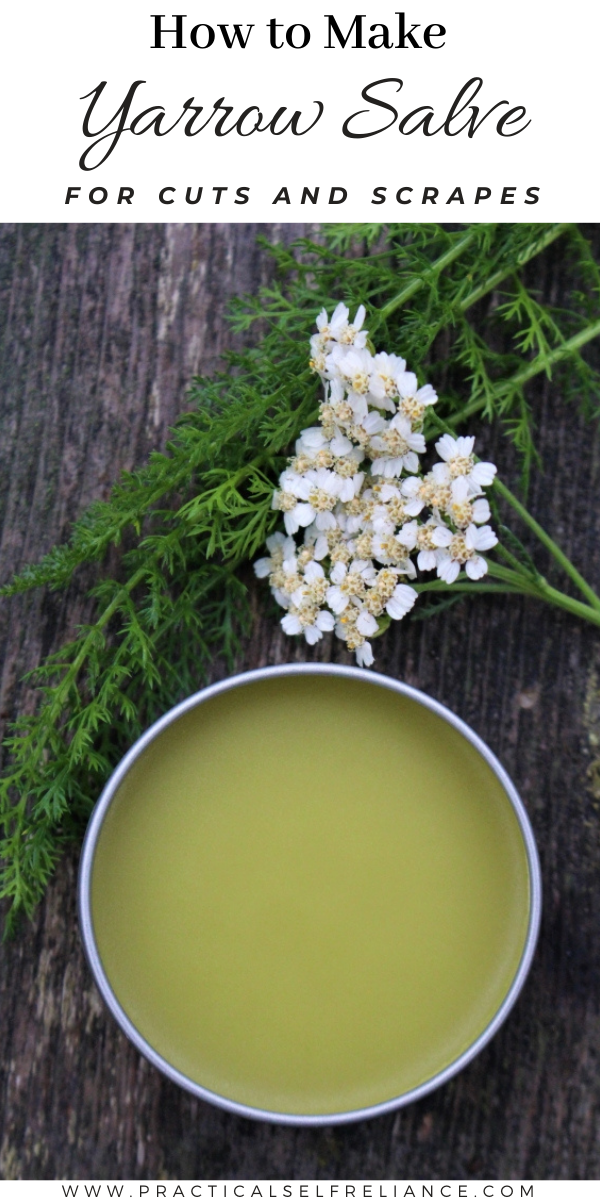
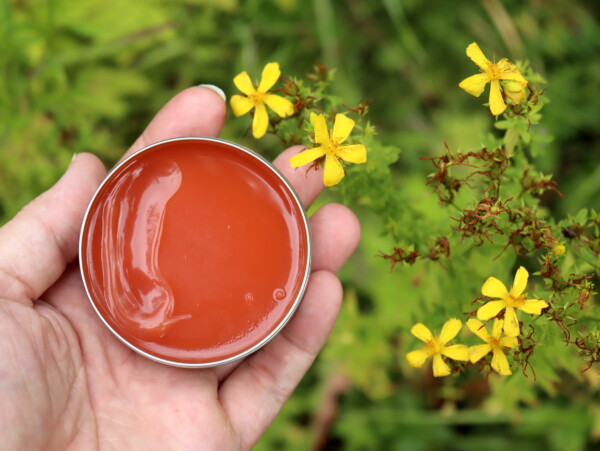
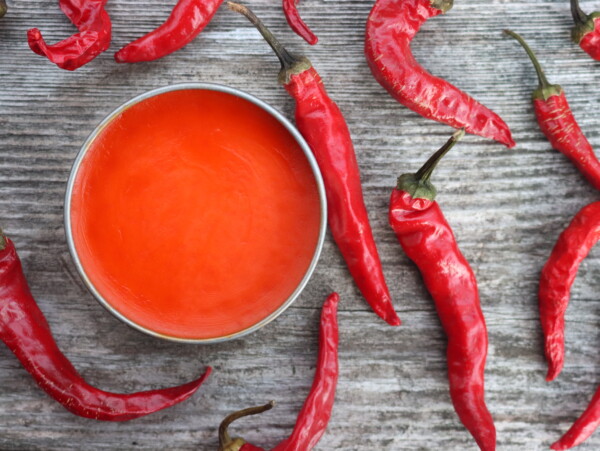
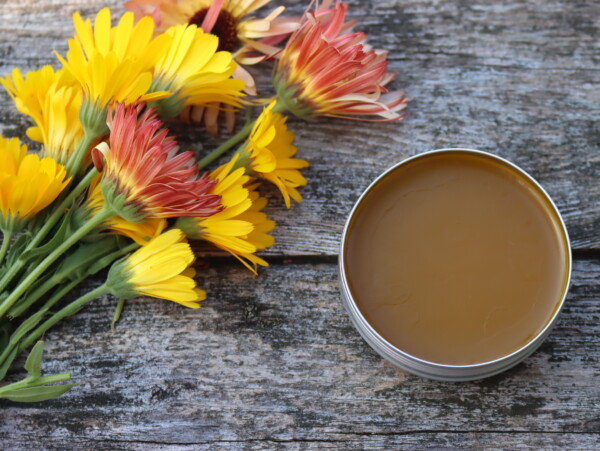
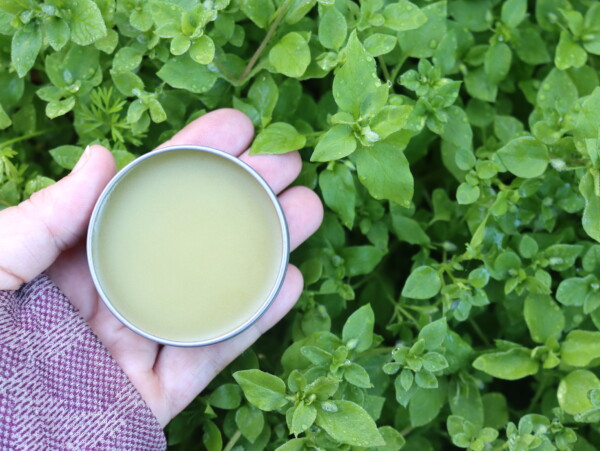
Would you recommend infusing the cold method for 4 weeks than the warm method for a few more hours? I read that would be alright.
Yarrow does just fine with both the cold and warm infusion methods. In a perfect world for the absolute best results, you’d use dried yarrow and slow infusion. But, if you need it sooner rather than later, and/or you don’t have access to dried, the quick infusion method works too. If you’re not in a rush and have dried yarrow, then go with slow infusion.
Are there any vegan alternatives you could recommend instead of beeswax?
Yes, check into candelilla wax. When substituting for beeswax, start off with about half the amount of candelilla wax. You may have to experiment a bit to get the consistency that you’re wanting. You can also try sunflower wax. It also doesn’t need as much as beeswax although I’m not sure of the exact measurement.
I live in Canada. The yarrow we have growing wild is yellow. Can I use this?
Thank you
This should work just fine. Different varieties may have slightly different properties. Unfortunately there hasn’t been a lot of research done to know for sure and I have heard differing opinions on this. When you rub the leaves, it should have a very medicinal smell to it.
You say to infuse oil till ready, how do I know when it’s ready? Thanks in advance. Edyt
It depends on whether you are using the slow infusion method with dried herbs which takes 3 to 6 weeks or the warm rapid infusion which is done in 24 to 48 hours. I usually try to let them go as long as possible to get the most medicine out of the herbs.
Hi! Thank you for sharing the yarrow salve recipe! I was just wondering could I infuse it with lavender as well?
Thank you!
You’re very welcome. Yes, you can certainly add some lavender as well. I typically prefer to do my oil infusions separately and then mix them together as needed so that I have a little more flexibility.
I am really looking forward to trying this, but I was wondering if I can do the diffusion in the dehydrator, or would that affect the oil?
Do you mean you want to infuse the oil in the dehydrator?
I don’t know. I have just used Yarrow oil
For pains in my legs.
You can just follow the instructions in the post to make a salve. You don’t need to use a dehydrator to make the actual salve.
Yes, rather than a pot on the stove I can leave the dehydrator running at a low temperature for hours. Would the drying affect the oil?
I guess you could try it. I’ve just never heard of anyone using a dehydrator for oil infusion.
Degrees what? Fahrenheit?
Yes, we are in the U.S. so all temperature measurements are Fahrenheit.
I need to find some yarrow.
Yarrow grows wild in many places. You can also find seeds and plant it in your garden or order dried yarrow from a reputable online source.
Is there a use for the flower? How do I know when to use the leaf vs the flower when using yarrow medicinally?
You can use the flowers or leaves or both together.
Hi! Excited to try this recipe!
If I am using dried yarrow, should I still pack a pint jar full? (That seems like a lot of dried yarrow). Or is there a proper conversion rate from fresh to dried quantities?
Thanks!
You can use about half the amount of dry plant material.
How long will this last before it “expires”?
Making salve is actually a common preservation method. This salve will last a very long time.
Great post and super informative! Trying this out with a slow cooker, fresh leaves, and olive oil. It’s been going about 36hrs but temperature fluctuates a lot with the slow cooker. 80f-120f depending how long I forget about it before bringing the temperature back up. The top of the oil is darkening quite a bit. Doesn’t smell rancid but is this bad? Thinking the inconsistent temp is a problem. Thanks in advance!!
Fluctuation isn’t really an issue as long as it doesn’t get too hot. It may just be getting dark from the plant matter. As long as it doesn’t smell rancid or burnt then it should be fine.
I have an oil infusion machine, similar to a magic butter machine, would I be able to use it to infuse the oil in this recipe? Or do I have to use the slow infusion method? My yarrow is currently fresh but I can dry it if that works better for the oil infusion machine.
You can definitely use the infusion machine for any oil infusion. I would just follow the directions for the machine regarding the infusion and then proceed with the rest of the instructions from there.
i can’t wait to try this over the weekend 🙂
Hi there, I live in the Caribbean, St. Kitts and Nevis if you were to look it up on a map.
Anyway I have several oils, but Yarrow is one of my favs. The problem that i have is
Yarrow isn’t grown here . Can you perhaps direct me to some other herb or flower.
We do grow Marigold flowers here but its really hard to obtain.
Love your site.
There are lots of herbs and flowers that you could use. It really depends on what specific benefits you are wanting to get from the salve. You could also check to see if you are able to grow yarrow there. Just because it isn’t currently growing there doesn’t necessarily mean that it can’t grow there. Yarrow grows in almost every climate. You could look into planting some and growing it yourself.
Hi Ashley, I heard somewhere that only the white yarrow should be used medicinally, but have not found anything online to support this. Do you know if this is true? I hope not because I’ve been making tinctures with pink yarrow from my yard 🙂
There are differing opinions on this. I have only personally worked with wild yarrow. I would recommend rubbing the leaves of the plant and if it smells medicinal then chances are good that it will have strong medicinal properties.
I will try that, thanks!
You’re very welcome.
I’ve enjoyed your website posts, and learned many things. I made the dandelion jelly last month, and had my 11 yrold granddaughter help. I was somewhat laborious, we got nicely brown stained finers, but the result was very good.
I have a question about the yarrow salve. I have a large patch of yellow yarrow which I got from a nursery some years ago. Is it ok to use those leave as well, or only from the white?
That is a darn good question, and one I honestly don’t have the answer to. I’ve looked into this, and no one’s really measured it. The wild type of white yarrow is known for its medicinal benefits, and the garden hybrids are just selections made off the wild type to the best of my knowledge. I’d assume they’d have the same medicinal benefits, but that’s an assumption, and you never know what gets kept or inadvertently bred out when selecting for ornamental varieties.
My herbologist said that you can use the colored yarrows the same was as the white.
You definitely can but many people do believe that the white or wild yarrow has more potent benefits although it’s impossible to know that for sure without specific testing and I’m not aware of any testing that has been done on that.
Thanks for the easy guide! My yarrow was getting a bit overgrown so needed something to trim it down for. I ended up making 3 tin fulls – not sure how fast I’ll use it. It was informative and fun + I followed your blog for more lol. Next time I think I’ll
– add more yarrow
– add more time
(I ended up using a slow cooker and it heated up my oils a bit faster than I liked)
So glad you enjoyed the recipe.
If using the beeswax as a thickener, could Shea butter or Cocoa butter or another type of hard butter be used as a thickener instead??
Yes, you should be fine to make that substitution in a salve.
Hi,
I can’t see the recipe for how much beeswax to add.
The ratio is 1 ounce of beeswax (by weight) to a cup of herb-infused oil. You need to start with a bit more oil, around 1 1/4 to 1 1/2 cups because you won’t be able to get it all off the yarrow after it’s infused.
WOW. Super helpful info. Thank you so much! My 200K tiktok followers will enjoy this too.
You’re very welcome.
I am glad you enjoyed the article. Thanks for sharing.